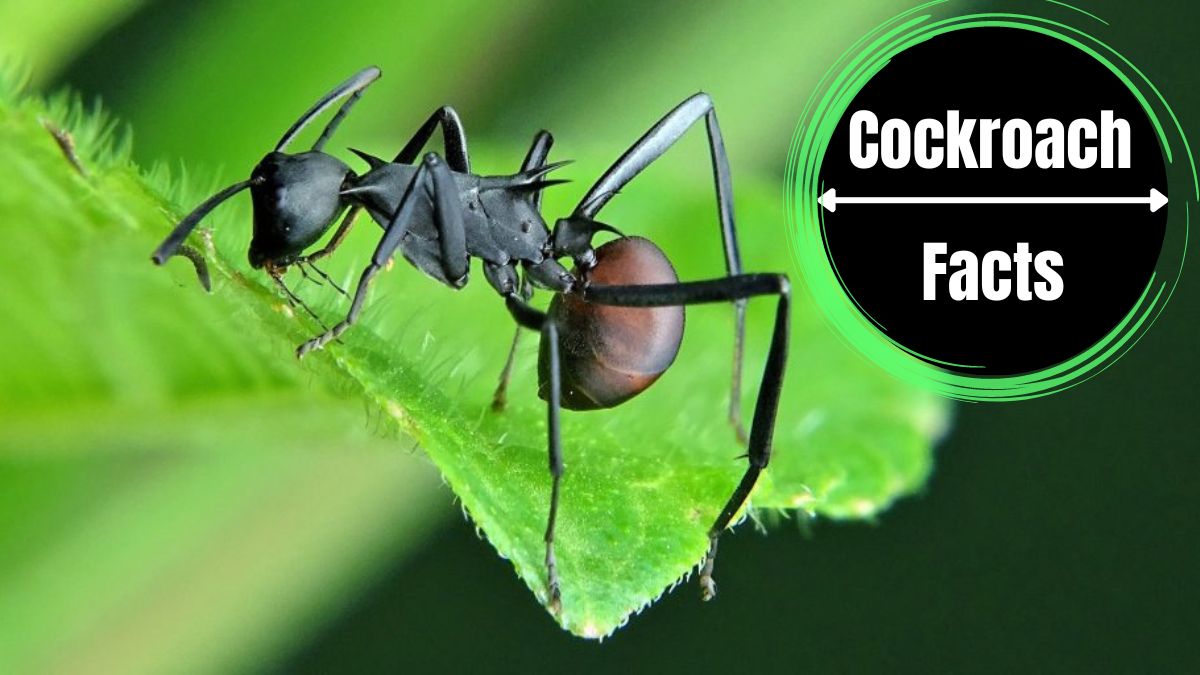Carpenter Ants, Acrobat ants, Carpenter bees, Powderpost beetles, and Flying Ants are bugs that look like termites. These bugs have several similarities with termites; therefore, they are often mistakenly considered termites, but actually, they are not termites and belong to another insect category. There are also many differences between these bugs and termites that help you to identify them. These differences are in color, body shape, size, wings, antennae, and feeding behaviour.
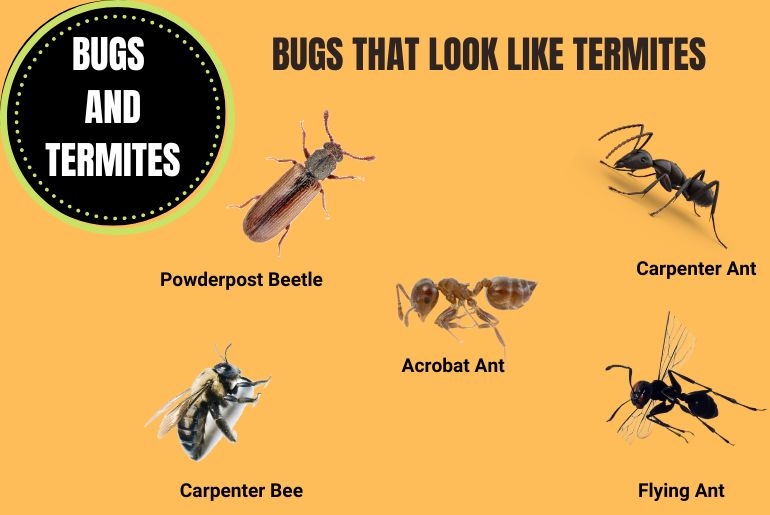
Carpenter Ants
Carpenter ants are often mistaken for termites because of their similar appearance. Both insects have long, slender bodies with wings, and they are both capable of causing damage to wooden structures. However, some key differences between the two insects help you differentiate carpenter ants and termites.
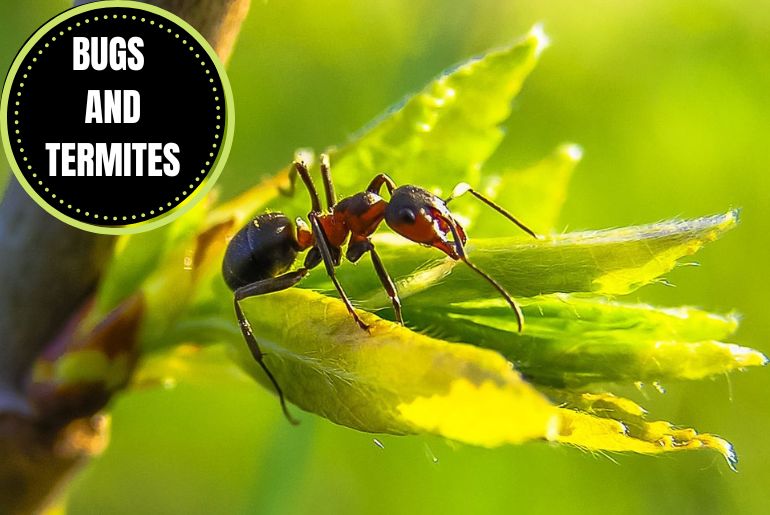
Body Shape
Carpenter ants have a more pronounced segmentation in their bodies, with their abdomens being noticeably narrower than their thoraxes. Termites, on the other hand, have more smoothly-rounded bodies with less pronounced segmentation. Also, carpenter ants have longer legs than termites, and their antennae are also longer. Overall the body shape of a carpenter ant is narrower and more segmented than a termite’s.
Color
Carpenter ants are black or red, while termites are white. The color difference also helps you to identify termites.
Antennae
Carpenter ants and termites have antennae that play an important role in their daily lives. The antennae of carpenter ants are used for communication and for exploring their surroundings. The antennae of termites are used for balance and sense vibrations in the ground. The carpenter ants’ antennae are longer than those of termites and have slightly different shapes. The antennae of carpenter ants are more curved, while those of termites are straight. The antennae of both insects are covered in tiny hairs that help them to detect movement and vibration.
Wings
Both insects have two pairs of wings that are different in shape and size. Carpenter ants have dark-coloured wings, while termites have lighter-coloured wings.
Life Cycle
Carpenter ants and termites both undergo complete metamorphosis, meaning they go through four distinct life cycle stages: egg, larva, pupa, and adult. However, there are some differences between the two. Carpenter ants can mate and reproduce while they are still in the larval stage, whereas termites cannot. Also, carpenter ants go through a process called pupation, during which they spin a cocoon around themselves and transform into adults, whereas termites simply shed their skin and emerge as adults.
Damages
Carpenter ants and termites are serious pests that can cause extensive damage to homes and other structures extensively. Carpenter ants are particularly attracted to wood and can tunnel through it to create nesting areas. This tunnelling can weaken the structural integrity of buildings and make them more susceptible to damage in the event of an earthquake or other disaster. Termites, on the other hand, feed on wood and can quickly consume large amounts of it, causing extensive damage to homes and other structures. In addition, termites can also spread diseases to humans and animals.
Causes of infestation
There are several potential causes of an infestation of carpenter ants or termites. One possibility is that the insects have been attracted to the property by a food source. This could be something as simple as spilt food or crumbs left on the floor. Another possibility is that there is a crack or hole in the property that the insects are using to get inside. This could be a gap in the foundation or a hole in the walls. The infestation will likely continue to grow if the problem is not addressed.
Carpenter Bees
Carpenter bees got their name because they built their nests by tunnelling into the wood. This tunnelling leaves behind a telltale sign: a small, round hole. These bees are often mistaken for termites because of this behaviour. However, there are some key differences between the two insects.
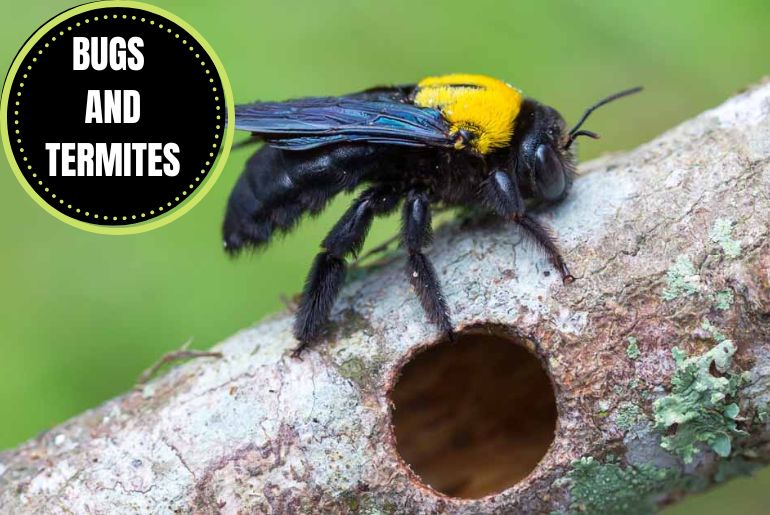
Size and Color
There is a difference between the size of carpenter bees and termites. Carpenter bees are about the size of a bumble bee, while termites are about the size of an ant. There is also a difference in the color of these two insects. Carpenter bees are black and yellow, while termites are white.
Antennae
There are several key differences between the antennae of carpenter bees and termites. Carpenter bees have much longer antennae than termites, often twice as long. Also, carpenter bee antennae are thinner and more delicate-looking than termites.
Wings
Carpenter bees have much larger wings than termites, which helps them fly faster and farther. On the other hand, termites have much smaller wings that allow them to only glide slowly from one place to another. Carpenter bee wings are much more curved than termite wings, giving them more lift and a better ability to fly in tight spaces. Termites have more straight-edged wings that help them stay stable while gliding but don’t give them as much manoeuvrability.
Risks
Carpenter bees and termites can both cause serious damage to your home. Carpenter bees tunnel into the wood, weakening structural integrity and potentially causing costly damage. Termites eat wood and can also cause serious damage.
Acrobat Ants
Acrobat ants get their name from their habit of raising their abdomens in the air when disturbed. This behaviour is similar to termites, so these ants are often mistaken for their wood-chewing cousins. But acrobat ants don’t eat wood; instead, they feed on other insects and honeydew, the sweet excretion of aphids and other plant-sucking pests.
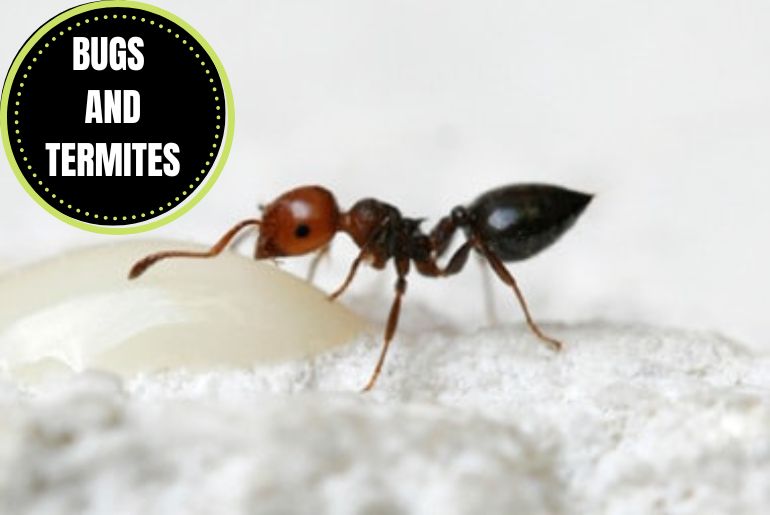
Feeding
Acrobat ants and termites are interesting creatures with unique feeding methods. Acrobat ants feed by gathering small insects and other food items and then carrying them back to their nest. Termites, on the other hand, feed by chewing through wood and other materials.
Size and Color
The Acrobat ants are small, while the termites are large. The Acrobat ants are black, while the termites are white.
Wings
Acrobat ants have shorter, more rounded wings, while termites have longer, more triangular wings. Also, acrobat ants typically use their wings for short bursts of flight to escape predators or to find mates, while termites use their wings for sustained flight during their annual mating rituals.
Antennae
There are several key differences between the antennae of acrobat ants and termites. Acrobat ants have longer antennae, while termites have shorter antennae. Acrobat ants also have more segments in their antennae, while termites have fewer segments. The shape of the antennae also differs between the two types of insects, with acrobat ants having more curved antennae and termites having straighter antennae.
Damage
Acrobat ants and termites are two of the most destructive pests in the world. They are known for their ability to devastate crops, destroy buildings, and cause other damage. These pests are difficult to control and often cause lots of yearly damage.
Powderpost Beetles
Powderpost beetles are a type of wood-boring beetle that gets its name from the finely powdered wood that it leaves behind as it bores into the wood. These beetles are often mistaken for termites because of their similar appearance and behavior. Both powderpost beetles and termites are small and winged insects attracted to wood. However, some key differences between them help people to differentiate these insects.
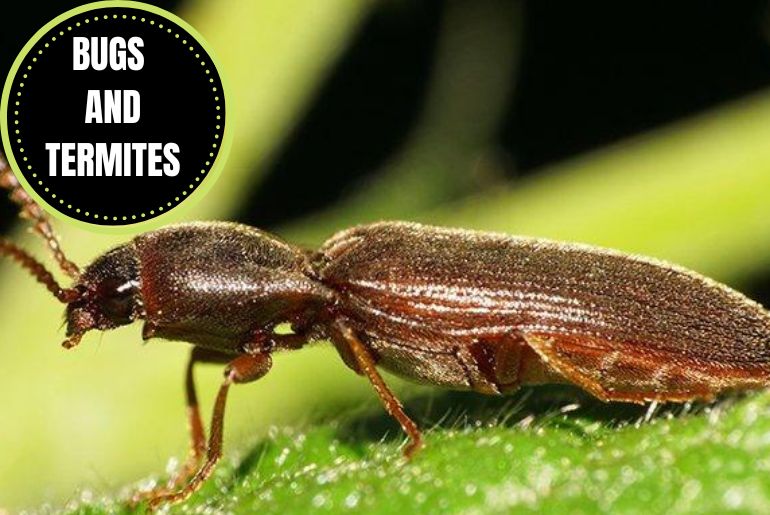
Size and Shape
Powderpost beetles are much smaller than termites, averaging around 3-5mm in length. This means that they can be more difficult to spot, as they can easily hide in cracks and crevices. Conversely, termites can be up to 10 times larger, making them much easier to spot. Powderpost beetles have a long, slender bodies, while termites have a more rounded body shape.
Feeding
There are several key differences between the feeding habits of powderpost beetles and termites. Powderpost beetles generally only eat the softer inner layers of wood, whereas termites will eat the entire piece of wood, including the hard outer layers. Also, powderpost beetles typically only feed on wood that is already dead or dying, whereas termites will feed on both living and dead wood.
Risks
Powderpost beetles and termites are both serious pests that can cause extensive damage to homes and other structures. The Powderpost beetles tunnel through wood, leaving small holes and piles of powdery frass. Termites eat wood from the inside out, leaving hollowed-out galleries. In order to prevent infestations, it is important to inspect the wood for signs of damage and to repair any damage promptly.
Flying Ants
Flying ants are considered termites because they have many similarities with termites. Both flying ants and termites have wings and can fly. They are both attracted to light and often enter homes through doors and windows. Both insects also damage wood by chewing on it. But these are two different insects with the following differences.
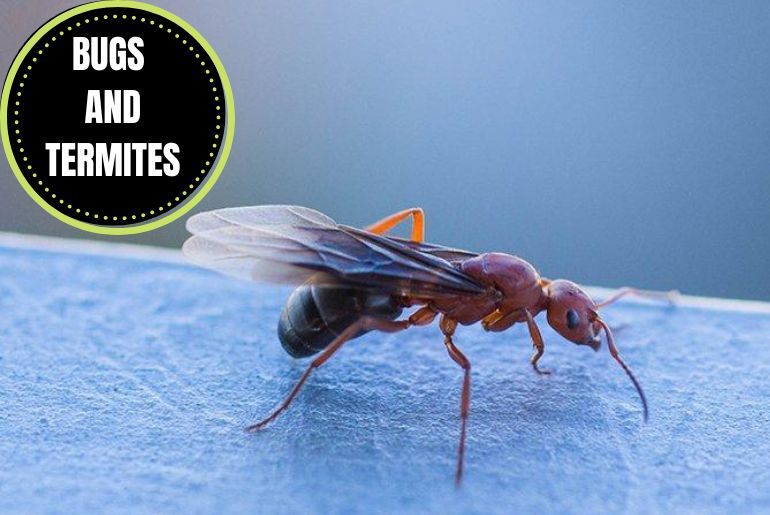
Antennae
Flying ants and termites have antennae, but they have some differences. Flying ants have longer and thinner antennae than termites. The antennae of flying ants are also more flexible, while the antennae of termites are more rigid. The antennae of flying ants are important for their sense of touch and smell. They use them to help them find food and mates. The antennae of termites are important for their sense of taste. They use them to help them find food and avoid predators.
Body
Flying ants and termites both have wings and can fly, but there are some key differences between their bodies. For one, flying ants have a narrower waist than termites. They also have longer legs in proportion to their bodies, and their wings are unequal in size. Termites, on the other hand, have thicker waist and their wings are equal in size. Another difference is that flying ants have compound eyes, while termites have simple eyes.
Size and Color
The flying ants have a larger size with two pairs of unequal wings. Termites are smaller in size, and their wings are equal in size. The color of termites is pale yellow but flying ants are darker in color.
Risks
Flying ants and termites can pose a serious threat to your home and property. These pests can cause extensive damage to your structure and may even lead to its collapse. In addition, flying ants and termites can also contaminate your food and spread disease. If you suspect that you have a problem with these pests, it is important to contact a professional pest control company immediately.
FAQS
Are there black termites?
Answer: There is some debate over whether or not there are black termites. Some people say they have seen them, while others insist they don’t exist. The jury is still out on this one, but black termites may exist. If they do, they are probably quite rare.
How do you tell the difference between an ant and a termite?
Answer: Ants are larger than termites, and their wings are unequal in size, while termites have equal wings. The termites are light yellow-coloured insects, but ants are darker in color.

